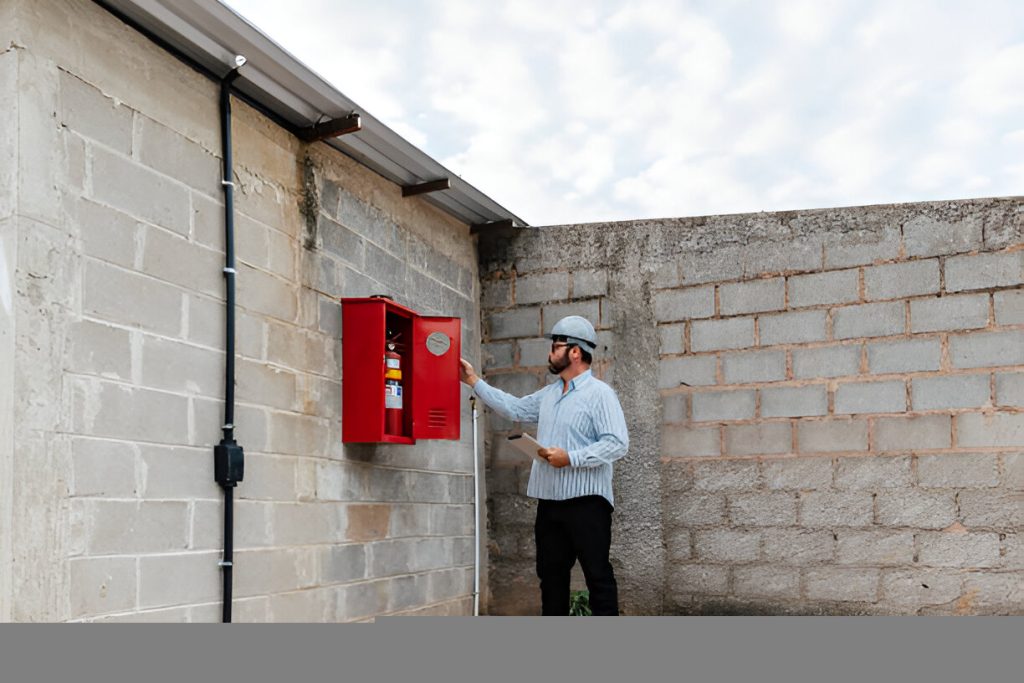Need a Fire Safety Certificate? Navigating UK fire safety regulations can be complex. Learn when a certificate is required, how it applies to your property type, and why compliance is essential for legal and occupant safety.
Key Takeaways
- Fire Safety Certificates are mandatory for new or extensively modified buildings in the UK.
- Private dwellings and individual flats usually do not require a certificate unless they are used for business.
- Small businesses with fewer than five employees are generally exempt from needing a certificate.
- Regular fire risk assessments are essential to determine if a certificate is necessary.
- Contact your local fire authority for specific guidance on compliance and certification requirements.
Fire Safety Certificates Explained: What Are They?
Fire safety certificates are crucial documents that confirm a building’s compliance with fire safety regulations in the United Kingdom. These certificates are issued following a thorough fire safety inspection UK process, ensuring that the premises meet stringent safety standards set forth by relevant fire safety legislation.
Typically, obtaining a fire safety certificate in the UK involves a comprehensive evaluation of the building’s design, construction, and fire protection measures, including alarms, escape routes, and firefighting equipment.

The certificate is a result of a detailed fire risk assessment certificate process, whereby a qualified assessor examines potential fire hazards within the building and evaluates the effectiveness of existing fire control measures. It is an essential document that signifies not only legal compliance but also a commitment to maintaining a safe environment for occupants.
Fire safety compliance is upheld through regular assessments and inspections to adapt to any changes in building use or structure, ensuring ongoing adherence to safety norms. This dynamic process helps in mitigating risks, safeguarding lives, and minimizing property damage in case of a fire.
The fire safety certificate thus serves as a pivotal document in the proactive management of fire risks in any establishment.
Who Is Responsible for Fire Safety Compliance in the UK?
Responsibility for ensuring fire safety compliance in the UK rests primarily with the designated ‘responsible person’ for each premises. This individual plays a pivotal role in managing fire safety measures to safeguard occupants and the property.
The term ‘responsible person’ can refer to:
- The Employer: In workplaces, the employer is typically the person responsible for implementing and maintaining fire safety protocols.
- The Owner: For non-workplace premises, the owner holds the responsibility. This includes landlords in residential properties where multiple occupancy is involved.
- The Occupier: Sometimes, especially in shared buildings, the occupier, such as a leaseholder or tenant might be designated as the responsible person.
The responsible person must carry out a detailed fire risk assessment, which is central to the strategic framework for fire safety. This assessment informs the preventive and protective measures that need to be in place.
They must also ensure that fire safety equipment is correctly installed and maintained, provide adequate training to staff or occupants, and keep all fire safety records up to date.
Failure to comply with these duties can lead to legal action, including significant fines or even imprisonment, underscoring the critical nature of these responsibilities.
When Do You Need a Fire Safety Certificate in the UK?
In the United Kingdom, a Fire Safety Certificate is mandatory for all newly constructed or extensively modified buildings before they are occupied. This requirement is stipulated under the Regulatory Reform (Fire Safety) Order 2005, which aims to ensure that any premises meet rigorous fire safety standards that protect occupants in the event of a fire. The certificate is issued by the local fire authority following a detailed assessment of the building’s fire safety design and installations.
The Need a Fire Safety Certificate extends beyond just new constructions. Significant alterations to existing structures, including refurbishment or changes in the building’s use that affect its fire safety provisions, also necessitate re-evaluation and potential re-certification.
For example, if an office building is converted into residential apartments, this use change will trigger the Need a Fire Safety Certificate to reflect the different safety requirements and risks associated.
Securing a Fire Safety Certificate involves comprehensive planning and collaboration with fire safety engineers and consultants who ensure that the design and functionalities of the building comply with current fire safety laws.
This process includes the installation of fire detection and suppression systems, proper emergency exits, and fire-resistant materials, among other critical safety measures.
Fire Safety Rules for Landlords and Business Owners
Landlords and business owners must adhere to strict fire safety regulations to ensure the well-being of tenants, employees, and visitors.
These regulations are designed not only to protect lives but also to minimize property damage in the event of a fire. Compliance is mandatory and non-negotiable under UK law, primarily governed by the Regulatory Reform (Fire Safety) Order 2005 and other local legislation.
To help you understand some of the critical requirements, here are three key rules:
- Risk Assessment: Landlords and business owners are required to conduct a thorough fire risk assessment of their premises. This assessment must identify potential fire hazards, evaluate the risks, and determine appropriate safety measures.
- Safety Measures and Equipment: Adequate fire detection and fire fighting equipment must be installed and maintained. This includes smoke alarms, fire extinguishers, and, where necessary, sprinkler systems. Regular checks and maintenance are essential to ensure they are always operational.
- Emergency Exits and Routes: Clear and accessible emergency exits and escape routes must be established and maintained. These routes should be marked, free of obstruction, and well-lit to facilitate quick evacuation in case of fire.
Understanding and implementing these rules can significantly enhance safety and compliance, safeguarding both individuals and investments.
What Properties Are Exempt from Fire Safety Certification?
When asking whether you need a Fire Safety Certificate, it’s important to understand that not all properties fall under this legal requirement in the UK. When navigating the nuances of fire safety certification, certain exemptions apply based on property type, usage, and occupancy.
Notably, private dwellings, individual flats in a block, and single-family homes generally do not need a Fire Safety Certificate unless they are used for commercial purposes or are subject to licensing—such as in the case of large HMOs (Houses in Multiple Occupation).

Furthermore, agricultural properties are often exempt, provided they are not open to the public and have fewer than five employees. Similarly, small businesses that employ fewer than five people and do not allow public access to their premises are usually not required to obtain a certificate. These exemptions aim to ease regulatory pressure on low-risk environments while prioritising fire safety in areas with greater public exposure or operational complexity.
Also excluded are structures such as small, non-residential agricultural and forestry buildings, as well as temporary buildings erected for less than 28 days.
Understanding whether you need a Fire Safety Certificate or qualify for an exemption helps property owners and managers stay compliant without incurring unnecessary administrative overhead, all while maintaining a commitment to safety.
How to Carry Out a Fire Risk Assessment
Understanding which properties are exempt from fire safety certification underscores the importance of conducting thorough fire risk assessments for those that are not. A fire risk assessment is a systematic evaluation aimed at identifying potential fire hazards, assessing the risks associated with them, and determining measures to mitigate these risks to ensure the safety of occupants and property.
To perform a comprehensive fire risk assessment effectively, follow these critical steps:
- Identify Fire Hazards: Locate potential sources of ignition, fuel, and oxygen. Common ignition sources include heaters, electrical equipment, and open flames. Fuels might be materials like paper, wood, and flammable liquids, whereas oxygen sources involve ventilators and unsealed windows.
- Evaluate the Risk to People and Property: Determine who is at risk, especially focusing on vulnerable groups such as the elderly, children, or those with mobility issues. Assess how likely a fire is to start and the probable consequences if it does.
- Record, Plan, and Train: Document your findings and formulate an emergency plan. Share this plan with all occupants and conduct regular training and drills. Review and update the assessment annually or whenever significant changes occur in the structure or occupancy of the building.
Penalties for Failing to Meet Fire Safety Regulations
Understanding whether you need a Fire Safety Certificate is only part of the responsibility—compliance with all UK fire safety regulations is mandatory, and failure to do so can result in severe legal consequences. Under the Regulatory Reform (Fire Safety) Order 2005, non-compliance can expose responsible persons—typically employers, owners, or occupiers of premises—to significant penalties.
These penalties range from substantial fines to imprisonment, depending on the seriousness of the breach. For minor infringements, fines can quickly escalate into the thousands of pounds, reflecting the level of risk the violation poses to public safety.
More serious offences—particularly where there is evidence of willful negligence or actual harm—can lead to criminal prosecution, where individuals may face up to two years in prison. These are often cases where there was a clear need for a Fire Safety Certificate that was ignored or inadequately handled.
In especially severe or repeat instances of non-compliance, authorities may also shut down premises, effectively halting operations until all fire safety measures are brought into full legal compliance. This not only serves as a punishment but also protects occupants from ongoing danger.
It is imperative for all responsible parties to fully understand if they need a Fire Safety Certificate and the broader scope of their obligations under fire safety law. Proactively ensuring compliance not only promotes safety but also protects against serious financial, legal, and reputational harm.
Where to Get a Fire Safety Certificate in the UK
Given the severity of penalties associated with non-compliance with fire safety regulations, obtaining a fire safety certificate is a fundamental step for any business or property owner in the UK.
The process to acquire this certificate is straightforward but demands attention to detail and a thorough understanding of the premises and its use.
To secure a fire safety certificate, consider the following steps:
- Contact Local Fire Authority: Your first point of contact should be the local fire authority (LFA). They provide guidance specific to your location and the type of property you own or manage. The LFA assesses fire safety measures and ensures compliance with the Fire Safety Order 2005.
- Hire a Qualified Fire Safety Assessor: Engage the services of a certified fire safety assessor. This professional will conduct a detailed fire risk assessment and suggest necessary improvements to enhance safety. Their expertise will be crucial in ensuring that all aspects of fire safety are addressed, making your application robust.
- Submission of Documentation: Submit the detailed fire safety assessment report along with any required supplementary documentation to your LFA. The authority will review your documentation and, if satisfied, issue the fire safety certificate.
Each step requires careful planning and adherence to regulations, ensuring not only legal compliance but also the safety of occupants and properties.
Frequently Asked Questions
Can a Fire Safety Certificate Expire?
Yes, a fire safety certificate can expire. The validity period depends on local regulations and the nature of the premises. Regular renewal and compliance checks are essential to ensure ongoing adherence to safety standards.
Are Digital Copies of Fire Safety Certificates Acceptable?
In the UK, digital copies of fire safety certificates are generally acceptable as valid documentation, provided they are accessible and can be verified as authentic by the responsible enforcement authorities during inspections.
How Often Should Fire Safety Training Be Conducted?
Fire safety training should be conducted annually to ensure compliance with regulations and maintain a high level of safety awareness. More frequent sessions may be necessary depending on changes in personnel or facility updates.
What Specific Fire Safety Equipment Is Mandatory?
In the UK, mandatory fire safety equipment includes fire extinguishers, smoke alarms, and emergency lighting. Businesses must also maintain marked fire exits and have appropriate fire blankets available in areas of increased risk.
Can Renovations Affect My Current Fire Safety Certificate?
Renovations can impact your fire safety compliance by necessitating updates or reevaluation of existing safety measures. It’s essential to consult with a fire safety expert to ensure your certificate remains valid post-renovation.
Do I need a Fire Safety Certificate in the UK?
You may need a Fire Safety Certificate if you are constructing a new building, making significant modifications to an existing one, or changing its use (e.g., converting a commercial space into residential units). Commercial properties, HMOs, and public buildings must obtain one in compliance with UK fire safety laws.






